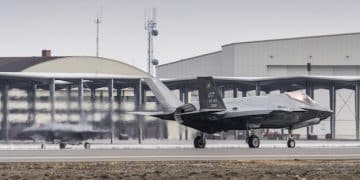How Would 7% Budget Increase Impact Defense Contracts in 2025?

The proposed 7% budget increase for the US defense sector in 2025 is poised to significantly reshape defense industry contracts, likely fostering new opportunities in advanced technologies, deepening prime contractor relationships, and intensifying competition among suppliers. It signals a strategic shift towards modernization and maintaining technological superiority against evolving global threats.
The landscape of the defense industry is perpetually in flux, dictated by geopolitical dynamics, technological advancements, and, critically, budget allocations. As discussions gain traction on how a proposed 7% budget increase will impact defense industry contracts in 2025, it becomes imperative for stakeholders—from prime contractors to smaller, specialized suppliers, and even policymakers—to meticulously analyze the potential ramifications. This anticipated surge in funding isn’t merely an incremental bump; it represents a strategic injection that could fundamentally reshape procurement priorities, foster technological innovation, and redefine competitive dynamics within this vital sector.
Understanding the Context of the Proposed 7% Increase
Before delving into the specifics of contract impacts, it’s crucial to grasp the underlying context driving this proposed 7% increase. Such a significant budgetary adjustment typically stems from a confluence of factors, including evolving global security threats, a desire to maintain technological superiority over near-peer adversaries, and the need to modernize aging military assets. This is not a random figure; it’s likely a calculated move designed to address perceived gaps and secure long-term strategic advantages for the nation.
The drivers behind this proposed increase are multifaceted. Geopolitical instability, particularly in regions experiencing heightened tensions or conflicts, often necessitates a bolstered defense posture. Furthermore, the rapid pace of technological innovation, especially in areas like artificial intelligence, quantum computing, and hypersonics, demands continuous investment to ensure the U.S. military remains at the cutting edge. This proactive investment aims to future-proof defense capabilities and ensure readiness against a diverse range of challenges.
Key Drivers for Budget Growth
Several primary factors are pushing for this increased defense spending. These drivers collectively paint a picture of a defense strategy focused on maintaining global leadership and addressing complex, emerging threats.
- Geopolitical Realities: The current international climate, marked by rising geopolitical competition and regional conflicts, underscores the need for robust defense capabilities.
- Technological Superiority: A persistent push to invest in disruptive technologies is essential to stay ahead of adversaries, ensuring the U.S. military’s technological edge.
- Force Modernization: Many existing military platforms and systems are reaching the end of their operational lifespans, necessitating significant investment in new equipment and infrastructure.
- Supply Chain Resilience: Strengthening domestic defense industrial bases and securing critical supply chains has become a paramount concern, driving investments in manufacturing and research.
Ultimately, this budget increase is not just about spending more; it’s about spending strategically. It reflects a commitment to adapting to a changing world, reinforcing national security, and ensuring the armed forces are equipped with the tools and technologies required to protect national interests and maintain stability. The implications for defense contractors are profound, as they will be at the forefront of translating these budgetary allocations into tangible capabilities.
The proposed 7% increase signals a clear intent to allocate substantial resources towards national security objectives. This top-line budget growth will percolate down to specific programs and contracts, setting the stage for significant shifts in the types and volumes of work available to the defense industry. Understanding these core motivations is the first step in anticipating the subsequent contractual impacts.
Shifting Priorities: What Technologies and Programs Will Benefit?
A significant budget increase rarely translates into a uniform uplift across all defense programs. Instead, it typically signals a strategic realignment of priorities, directing funds towards areas deemed most critical for future warfare and national security. The proposed 7% increase for 2025 is expected to heavily favor advanced technologies and specific modernization initiatives, echoing current strategic defense reviews.
We anticipate a pronounced emphasis on next-generation capabilities that can provide a decisive advantage in complex operating environments. This includes continued investment in areas that have been identified as pivotal for future conflicts, moving beyond traditional platforms to embrace networked and highly intelligent systems. The focus will likely shift from incremental improvements to transformative leaps in capability.
Areas of Heightened Investment
Key technological and programmatic areas are poised to receive substantial boosts from this funding increase. Contractors specializing in these fields will likely see an uptick in opportunities.
- Artificial Intelligence (AI) and Machine Learning (ML): From autonomous systems to advanced data analytics for intelligence and logistics, AI/ML integration across defense operations will be a top priority. Contracts in these areas will focus on developing, testing, and deploying AI-powered solutions that enhance decision-making and operational efficiency.
- Cybersecurity and Information Warfare: As digital threats proliferate, robust cybersecurity defenses and offensive capabilities are paramount. Expect significant contracts for developing secure networks, advanced threat detection systems, and tools for information dominance.
- Hypersonic Capabilities: The race for hypersonic weapons, both offensive and defensive, remains intense. Increased funding will likely accelerate research, development, and eventual procurement of these high-speed platforms.
- Quantum Technologies: While still in early stages, quantum computing and communication hold immense promise for defense. Initial research contracts for exploring quantum applications in cryptography, sensing, and navigation could see substantial growth.
- Space-based Systems: The militarization of space continues, driving demand for resilient satellite constellations, advanced space surveillance, and secure communication networks.
- Next-Generation Air Dominance (NGAD): This program, encompassing a family of systems rather than a single aircraft, aims to secure air superiority for decades to come, with significant investment in stealth, sensors, and networked capabilities.
Beyond these cutting-edge technologies, there will also be sustained investment in modernizing conventional forces. This includes upgrading existing fleets of aircraft, ships, and ground vehicles, along with significant spending on maintenance, repair, and overhaul (MRO) services to ensure operational readiness. The balance between revolutionary technology and evolutionary upgrades will be key in budget allocation.
Furthermore, the increase will likely fund continued, large-scale procurement programs for established platforms, such as continued production of fighter jets, naval vessels, and armored vehicles, albeit with an emphasis on incorporating new technologies into these platforms. The aim is to ensure that even legacy systems can benefit from and integrate with advanced capabilities, creating a more cohesive and formidable fighting force.
Impact on Prime Contractors vs. Small and Medium Enterprises (SMEs)
The allocation of a 7% budget increase inevitably creates ripple effects through the entire defense industrial base, affecting companies of all sizes differently. Historically, prime contractors—the Lockheed Martins, Raytheons, Boeings of the world—tend to be the primary beneficiaries of large defense spending increases due to their capacity to handle multi-billion dollar programs. However, the nature of modern defense procurement, with its emphasis on innovation and specialized technologies, also creates distinct opportunities for SMEs.
For prime contractors, the increased budget likely means an expansion of existing programs and the initiation of new, large-scale projects. Their established infrastructure, extensive R&D capabilities, and long-standing relationships with the Department of Defense (DoD) position them to capture a substantial portion of the new funding. This will translate into boosted revenues, increased backlogs, and potentially, accelerated development cycles for major systems.
Opportunities for Prime Contractors
Prime contractors are set to consolidate their positions and expand their portfolios in several key areas:
- Major Platform Production: Continued and expanded production contracts for aircraft, ships, and ground systems will dominate their portfolios.
- Integration of Complex Systems: Primes will lead the charge in integrating cutting-edge technologies (AI, quantum, hypersonics) into existing and new platforms, leveraging their systems engineering expertise.
- Large-Scale R&D Programs: They will secure significant funding for extensive research and development initiatives, particularly those requiring vast resources and multi-disciplinary teams.
Conversely, while SMEs may not directly secure multi-billion dollar prime contracts, their role is increasingly critical due to their agility, specialized expertise, and capacity for disruptive innovation. The DoD is actively seeking out smaller, more innovative companies, especially those in the commercial tech sector, to bring novel solutions to defense challenges. This budget increase could accelerate such partnerships.

Role of Small and Medium Enterprises
SMEs, often agile and specialized, will find opportunities through several avenues:
- Subcontracting Opportunities: Primes rely heavily on a robust supply chain. Increased prime contracts mean more subcontracting opportunities for SMEs in specialized components, software, and services.
- Direct DoD Contracts (SBIR/STTR): Targeted programs like the Small Business Innovation Research (SBIR) and Small Business Technology Transfer (STTR) initiatives are designed to funnel funds directly to SMEs for innovative R&D. Increased overall budgets often lead to expanded allocations for these programs.
- Niche Technology Providers: Companies specializing in emerging technologies (e.g., custom AI algorithms, advanced materials, specialized sensors) will be sought after for their unique capabilities and rapid prototyping abilities.
- Cybersecurity and Software Development: Many advanced cybersecurity and bespoke software solutions are developed by smaller, specialized firms, making them attractive partners.
The challenge for SMEs will be navigating the administrative complexities of defense contracting and scaling their operations to meet increased demand. However, the budget increase is likely to foster symbiotic relationships, where primes leverage SME innovation, and SMEs gain access to larger projects and resources. This dynamic ensures that while prime contractors secure the bulk of the larger programs, the innovation ecosystem of the defense industrial base remains vibrant and diverse through the contributions of SMEs.
Competitive Dynamics and Market Consolidation
A significant budget influx, such as the proposed 7% increase, inevitably intensifies competitive dynamics within the defense industry. While it promises growth, it also raises questions about market consolidation, the entry of new players, and the strategies companies will employ to capture their share of the expanded pie. Elevated budgets can either spur robust competition or, paradoxically, accelerate consolidation as larger entities acquire smaller ones to enhance capabilities and market share.
The immediate effect will be fierce competition for the larger, more lucrative contracts. Companies will redouble their efforts in lobbying, competitive bidding, and demonstrating unique value propositions. This environment will likely favor companies that have already invested heavily in R&D, possess robust supply chains, and can quickly scale operations to meet increased demand.
Intensified Competition for Key Programs
The scramble for new contracts will be particularly pronounced in high-priority areas:
- Advanced Technology Segments: Companies vying for contracts in AI, hypersonics, and quantum technologies will face stiff competition, pushing them to innovate rapidly and showcase mature solutions.
- Cybersecurity Solutions: The fragmented nature of the cybersecurity market means numerous players will compete for a growing pool of contracts.
- Systems Integration: As the DoD seeks more integrated, network-centric warfighting capabilities, competition for prime systems integrator roles will heighten.
In parallel to intensified competition, there is often a natural tendency towards market consolidation during periods of increased spending. Larger companies, flush with capital from new contracts, may look to acquire smaller, specialized firms to quickly gain access to niche technologies, intellectual property, or skilled labor. This “buy versus build” strategy can reduce competition in specific segments but also integrate critical innovations more rapidly into larger defense ecosystems.
Potential for Market Consolidation
Consolidation can manifest in several ways:
- Acquisitions of Tech Start-ups: Established primes may acquire agile tech start-ups to bolster their capabilities in AI, software, or quantum computing.
- Mergers of Mid-tier Companies: Faced with the need to achieve economies of scale or expand their service offerings, mid-tier defense contractors might consider mergers.
- Supply Chain Integration: Companies might acquire key suppliers to strengthen their supply chain resilience and reduce dependencies on external vendors, especially for critical components.
The defense sector has historically seen waves of consolidation linked to budget cycles. While increased budgets generally lead to more opportunities, they also incentivize companies to achieve greater scale and efficiency to manage larger programs effectively. Regulators will play a crucial role in overseeing these dynamics, ensuring that consolidation does not unduly stifle competition or innovation in the long run. The overall result will be a more streamlined, though potentially less diverse, market landscape for core defense capabilities, while still leaving ample room for specialized innovation at the SME level. The industry will need to strike a balance between aggressive competition for new work and strategic partnerships that ensure the DoD receives the best possible solutions.
Supply Chain Implications and Workforce Adaptation
A 7% budget increase doesn’t just impact the top-tier contractors; it sends reverberations throughout the intricate supply chain that underpins the entire defense industrial base. The demand generated by bolstered contracts will place significant pressure on suppliers of raw materials, components, and specialized services. Simultaneously, the industry will face the persistent challenge of workforce adaptation, requiring new skills and a strategic approach to talent development.
The immediate implication for the supply chain is increased demand. Manufacturers of everything from semiconductors to specialized alloys, and providers of complex sub-assemblies, will experience a surge in orders. This heightened demand could, if not managed proactively, exacerbate existing supply chain vulnerabilities, such as reliance on foreign sources for critical minerals or components. Therefore, a focus on domestic sourcing and supply chain resilience will likely become even more pronounced.
Challenges and Opportunities in the Supply Chain
The supply chain will face both opportunities for growth and critical challenges:
- Increased Demand and Backlogs: Suppliers will see their order books swell, potentially leading to longer lead times and the need for expanded production capacities.
- Resilience and Diversification: There will be a stronger push for diversifying supply chains, reducing single points of failure, and potentially re-shoring production of critical components.
- Technology Adoption: Suppliers will need to adopt advanced manufacturing techniques, such as additive manufacturing and smart factory technologies, to meet evolving demands and improve efficiency.
Beyond materials and components, a thriving defense sector needs a highly skilled workforce. The shift towards advanced technologies like AI, cyber, and quantum computing necessitates engineers, scientists, and technicians with specialized expertise. The current workforce, while robust in traditional areas, may require retraining or upskilling to meet these emerging needs. Attracting new talent, particularly from the tech sector, will be paramount.

Workforce Adaptation Strategies
Addressing human capital needs will be critical for sustained growth:
- Talent Recruitment: The industry will need to actively recruit a new generation of engineers and scientists, particularly those with expertise in software, data science, and advanced hardware design.
- Upskilling and Reskilling Programs: Significant investment in training programs will be required to equip the existing workforce with the skills needed for next-generation defense systems.
- Public-Private Partnerships: Collaboration between industry, academia, and government will be essential to develop specialized curricula and apprenticeship programs.
- Addressing Retention Issues: Competitive compensation and attractive career paths will be vital to retain highly skilled personnel in a competitive job market.
The increased budget will undoubtedly spur job creation within the defense sector and its broader supply chain. However, the nature of these jobs will evolve, demanding a strategic approach to workforce development. Companies that proactively invest in their human capital and cultivate resilient, diversified supply chains will be best positioned to capitalize on the opportunities presented by the increased defense budget in 2025. This dual focus on material flow and human talent will be key to translating budgetary increases into actual capabilities.
Ethical Considerations and Oversight Challenges
While an increased defense budget promises enhanced national security and economic stimulus, it also brings into sharp focus a series of ethical considerations and oversight challenges. The sheer scale of spending demands rigorous accountability to ensure funds are used efficiently, transparently, and in a manner that aligns with public trust and strategic objectives. Without robust oversight, the potential for waste, fraud, and abuse can escalate, eroding confidence in defense expenditures.
One primary ethical concern revolves around the potential for “revolving door” scenarios, where former government officials transition to lucrative positions within defense contracting firms, raising questions about conflicts of interest and undue influence. Similarly, the drive for new contracts can sometimes overshadow cost-effectiveness and genuine necessity, leading to programs that are over budget or underperform. Maintaining public trust in how taxpayer money is spent on defense is paramount.
Key Ethical Considerations
Deliberate attention must be paid to various ethical dimensions:
- Transparency in Contracting: Ensuring that contract awards are fair, competitive, and transparent, minimizing opportunities for cronyism or biased decision-making.
- Cost Control and Efficiency: Preventing cost overruns and ensuring that defense programs deliver maximum value for taxpayer money, rather than simply expanding budgets for the sake of it.
- Responsible Innovation: Guiding the development and deployment of new technologies, particularly in AI and autonomous systems, according to ethical guidelines and international norms.
- Preventing Conflicts of Interest: Implementing strict rules to manage potential conflicts of interest among officials and contractors.
Accompanying these ethical considerations are significant oversight challenges. The complexity of defense programs, often involving multiple contractors, subcontractors, and highly specialized technologies, makes comprehensive oversight a daunting task. Legislators, auditors, and internal DoD watchdogs must be adequately resourced and empowered to scrutinize spending, identify inefficiencies, and hold parties accountable.
Oversight Challenges
Effective oversight requires navigating several complexities:
- Program Complexity: Tracking progress and expenditures for highly complex, multi-year programs requires sophisticated auditing and management tools.
- Technological Opacity: As defense technologies become more advanced and proprietary, it can be challenging for non-specialists to assess their true value and potential pitfalls.
- Rapid Procurement Demands: The pressure to rapidly procure advanced capabilities can sometimes lead to rushed processes that bypass thorough oversight mechanisms.
- Interagency Coordination: Ensuring consistent oversight across various government agencies involved in defense acquisition.
The proposed 7% budget increase for 2025 amplifies the importance of these ethical and oversight concerns. Robust mechanisms for compliance, independent auditing, and whistleblower protection will be essential to ensure that the increased funding genuinely strengthens national security without compromising integrity or public confidence. Balancing the need for rapid capability development with stringent fiscal and ethical stewardship will be a continuous challenge for all stakeholders involved in defense contracting.
Ultimately, the success of the budget increase in achieving its strategic goals will not only depend on the technologies acquired but also on the public’s confidence in the responsible allocation and management of these significant funds. Striking this balance between enhanced capability and unwavering accountability is a defining challenge for the defense industry in the coming years.
The Long-Term Economic and Geopolitical Repercussions
The proposed 7% budget increase for defense in 2025 is not merely a short-term financial adjustment; it carries significant long-term economic and geopolitical repercussions. Economically, it represents a substantial injection of capital into a specific industrial sector, while geopolitically, it signals a strategic posture to allies and adversaries alike. Understanding these broader impacts is crucial for a complete picture of the budget increase’s effects.
Economically, an expanded defense budget can act as a powerful stimulus, particularly in regions with a high concentration of defense contractors and manufacturing facilities. It creates and sustains high-paying jobs, fosters innovation in related sectors, and stimulates demand within the supply chain. However, economists often debate the efficiency of defense spending as an economic stimulus compared to other forms of government investment, considering its concentrated benefits and potential for crowding out other investments.
Economic Implications
The economic footprint of increased defense spending extends widely:
- Job Creation and Retention: Direct and indirect job growth across engineering, manufacturing, research, and support services.
- Regional Economic Impact: Significant benefits for states and localities with major defense installations or contractor presence.
- Technological Spillovers: Defense R&D often leads to innovations with commercial applications, benefiting other sectors like aerospace, IT, and advanced materials.
- Challenges of Dependency: Regions or industries that become overly reliant on defense spending can be vulnerable to future budget cuts or program shifts.
From a geopolitical standpoint, presenting a robust and growing defense budget sends a clear message. It signals a nation’s commitment to maintaining its security interests, supporting its allies, and projecting power. For adversaries, it can serve as a deterrent, indicating an unwillingness to be outmatched. However, it can also be perceived as escalatory by some, potentially catalyzing an arms race or exacerbating international tensions.
Geopolitical Ramifications
The strategic message conveyed by the budget is multi-layered:
- Deterrence and Assurance: A strong defense budget underpins deterrence against potential aggressors and reassures allies of continued support.
- Influence in Global Affairs: Military strength often translates into greater diplomatic leverage and influence on the international stage.
- Arms Race Dynamics: Significant increases in defense spending by one major power can prompt rival nations to increase their own military expenditures, leading to an arms race.
- Resource Allocation Debate: Domestically, large defense budgets inevitably spark debates about the allocation of national resources and priorities between defense and other critical sectors like education, healthcare, or infrastructure.
Ultimately, the long-term repercussions of the proposed 7% defense budget increase will depend on how strategically the funds are utilized, how effectively the economic benefits are distributed, and how diplomatically the signal of increased military might is managed on the global stage. It’s a complex interplay of economic reality and strategic intent, with outcomes that will shape both domestic prosperity and international stability for years to come.
The discussions around this budget increase extend far beyond mere numbers on a ledger. They represent a fundamental choice about national priorities, global posture, and the kind of future a nation seeks to build, making its detailed examination crucial for all parties involved.
| Key Impact | Brief Description |
|---|---|
| 🚀 Strategic Focus | Directs significant funds to advanced tech like AI, hypersonics, and quantum, prioritizing next-gen capabilities. |
| 💼 Contract Opportunities | Expands major programs for primes and creates more subcontracting/direct R&D for SMEs. |
| ⚙️ Supply Chain Pressure | Increases demand on suppliers, pushing for greater domestic resilience and efficiency. |
| ⚖️ Oversight Challenges | Requires stringent oversight to ensure transparency, prevent waste, and uphold ethical standards in a larger budget. |
Frequently Asked Questions About Defense Budget Impacts
The proposed increase is primarily driven by evolving geopolitical threats, the need to maintain technological superiority over adversaries, and the ongoing modernization requirements for aging military assets. It reflects a strategic imperative to invest in cutting-edge capabilities and enhance readiness to ensure national security in a complex global environment.
Advanced technologies such as Artificial Intelligence (AI), cybersecurity, hypersonics, quantum computing, and space-based systems are expected to receive significant boosts. These areas are critical for future warfare, enabling enhanced decision-making, defensive capabilities, and strategic advantage. Investment will also continue in next-generation platforms like the NGAD program.
While prime contractors will secure major programs, SMEs are set to benefit through increased subcontracting opportunities, particularly in specialized components and software. Direct DoD contracts via SBIR/STTR programs may also see expanded allocations, fostering innovation from agile, niche technology providers crucial for the defense industrial base.
The primary challenges include increased demand leading to potential backlogs, the need for greater supply chain resilience to reduce dependencies on foreign sources, and the imperative for suppliers to adopt advanced manufacturing technologies. Managing these factors proactively will be crucial for sustained growth and efficient delivery.
Increased ethical scrutiny is expected regarding transparency in contracting, preventing conflicts of interest, and ensuring cost control. Oversight challenges include managing the complexity of programs and rapidly evolving technologies. Robust auditing and accountability mechanisms are vital to ensure public trust and efficient use of taxpayer funds.
Conclusion
The proposed 7% budget increase for defense in 2025 represents a pivotal moment for the defense industry, signaling a decisive shift towards advanced capabilities and strategic modernization. This significant investment is poised to reshape contract landscapes, heavily favoring technologies like AI, hypersonics, and cybersecurity, while simultaneously bolstering opportunities for both large prime contractors and agile small and medium enterprises through an intricate web of direct and subcontracting awards. While promising robust economic activity and technological advancement, the increase also underscores critical challenges related to supply chain resilience, workforce development, and the imperative for stringent ethical oversight. Navigating these complexities effectively will be paramount to ensuring that the substantial investment translates into tangible national security enhancements and maintains public confidence. The coming years will undoubtedly be defined by how collaboratively and strategically all stakeholders adapt to this new fiscal reality, influencing not only the future of defense but also broader economic and geopolitical dynamics.





